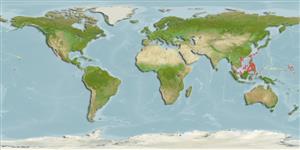>
Kurtiformes (Nurseryfishes, cardinalfishes.) >
Apogonidae (Cardinalfishes) > Pseudamiinae
Etymology: Gymnapogon: Greek, gymnos = naked + Greek, pogon = beard (Ref. 45335).
More on author: Herre.
Environment: milieu / climate zone / depth range / distribution range
Écologie
marin récifal; profondeur 0 - 9 m (Ref. 57178). Tropical; 30°N - 1°N
Pacific Ocean: Philippines, Taiwan, Ryukyu Islands, Kapingamarangi and Marshall Islands (Ref. 275) south to Australia (Ref. 75174). Recently reported from the Chesterfield Islands (Ref. 11897) and Tonga (Ref. 53797).
Taille / Poids / Âge
Maturity: Lm ? range ? - ? cm
Max length : 5.0 cm SL mâle / non sexé; (Ref. 48635)
Description synthétique
Clés d'identification | Morphologie | Morphométrie
Épines dorsales (Total) : 7; Rayons mous dorsaux (Total) : 9; Épines anales: 2; Rayons mous anaux: 8.
Sometimes occurs in schools of Rhabdamia gracilis (Ref. 1602). Rarely noticed because of small size (Ref. 48635). Occasionally collected with ichthyocides (Ref 90102).
Life cycle and mating behavior
Maturité | Reproduction | Frai | Œufs | Fécondité | Larves
Distinct pairing during courtship and spawning (Ref. 205).
Myers, R.F., 1991. Micronesian reef fishes. Second Ed. Coral Graphics, Barrigada, Guam. 298 p. (Ref. 1602)
Statut dans la liste rouge de l'IUCN (Ref. 130435: Version 2024-1)
Menace pour l'homme
Harmless
Utilisations par l'homme
Outils
Articles particuliers
Télécharger en XML
Sources Internet
Estimates based on models
Preferred temperature (Ref.
123201): 25.4 - 29.1, mean 28.7 °C (based on 636 cells).
Phylogenetic diversity index (Ref.
82804): PD
50 = 0.5039 [Uniqueness, from 0.5 = low to 2.0 = high].
Bayesian length-weight: a=0.00389 (0.00180 - 0.00842), b=3.12 (2.94 - 3.30), in cm total length, based on all LWR estimates for this body shape (Ref.
93245).
Niveau trophique (Ref.
69278): 4.0 ±0.50 se; based on food items.
Résilience (Ref.
120179): Haut, temps minimum de doublement de population inférieur à 15 mois (Preliminary K or Fecundity.).
Fishing Vulnerability (Ref.
59153): Low vulnerability (10 of 100).
